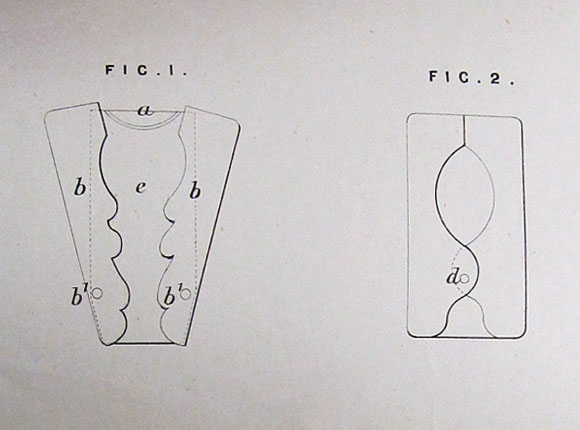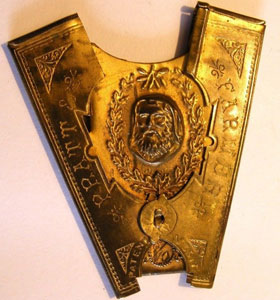Christmas Pincer
Name assigned based on exterior decoration

Needle Case (photographs from eBay)

Patent (patent #3517 in incorrectly stamped on the actual needle case)
Design Details
Needle Case Type: |
Flat-Names |
Patent/Registered to: |
William Avery - Redditch Manufacturer |
Patent/Design Representation #: |
Mechanical Patent #: 1473 (Fig. 1 & 2) |
Patent/Design Registration Date: |
May 21, 1870 |
Location of Patent/Design Registration: |
British Library - Business and Intellectual Property Centre - London
|
Reference #: |
1870-1473 |
Dimensions: |
2.3 x 4.5 |
Material: |
Brass |
Name Variations: |
Pratt & Farmer - New York |
Other Variations: |
a) Floral Bouquet Pincer
b) Minerva Pincer |
Additional Photographs


Open and exterior detail

Exterior detail showing patent number
Facts

In England the image of a merry old man associated with Christmas dates to the 17th century. Prior to this a pagan figure dressed in
green with holly, ivy or mistletoe representing the coming of spring appeared at British winter solstice festivities. The first reference
to Father Christmas was found in a carol in the 15th century and in 1638 the first illustration of him appeared. At this time Father
Christmas represented the spirit of Christmas with good cheer and benevolence to all and encouraged adults to eat, drink and be merry.
However, the Puritans banned Christmas and Father Christmas temporarily in 1644 because they did not like the reverence given to a pagan
figure. Although Father Christmas went underground for a period of time, during the Victoria era he was revived and portrayed as a
large, jolly, pagan figure dressed in a long, often red hooded coat with a handful of holly.
History

The German tradition of decorating a Christmas tree was introduced to Britain by George III’s German wife in 1800. Although at first
the custom was confined to the royal family its popularity spread when Queen Victoria married her German cousin Prince Albert. The drawing
above of the Queen's Christmas tree at Windsor Castle was published in The Illustrated London News in 1848. It didn’t take long
for the Christmas tree to become the centerpiece of a Victorian Christmas. The first Christmas card was designed in 1843 in London and
only 2,050 were printed. Early Christmas cards contained flowers and fanciful designs that reminded the recipient of the approaching
spring; however cards became more popular after the introduction of a less expensive method of color lithography. Later winter scenes,
many including children in the snow, Father Christmas or Christmas Trees like the one shown below, were common.

Miscellaneous
Charles Dickens was born in 1812 in Portsmouth, England and became the greatest novelist of the Victorian Period. When he was twelve
years old his family had financial difficulties which resulted in his father being sent to a debtor’s prison and Charles being forced to leave
school and work ten-hour days in a warehouse. As a result of this experience, the conditions in which working-class people lived became
an important part of his writing. In his early 20’s Dickens became a political journalist and in 1836 published his first collection of
stories. Although his 1859 novel “A Tale of Two Cities” is the best-selling novel of all time, his story “A Christmas Carol” which was
first published in 1843 helped paved the way for a change in how the Victorians celebrated Christmas. The focus shifted away from a
church-based holiday to a family oriented celebration which continues to this day. Dickens died in 1870.














